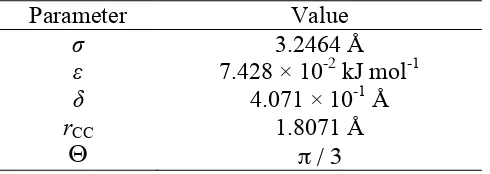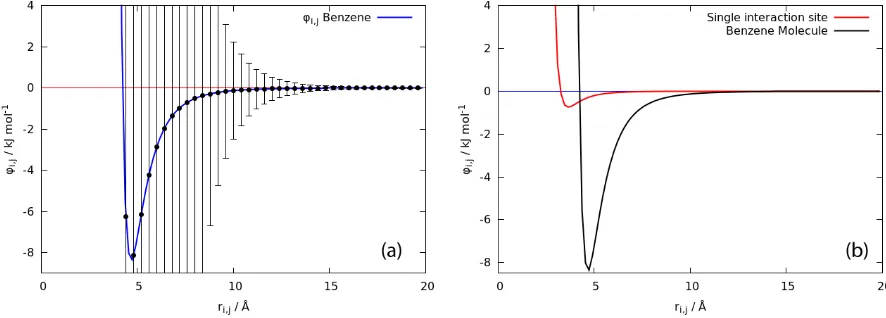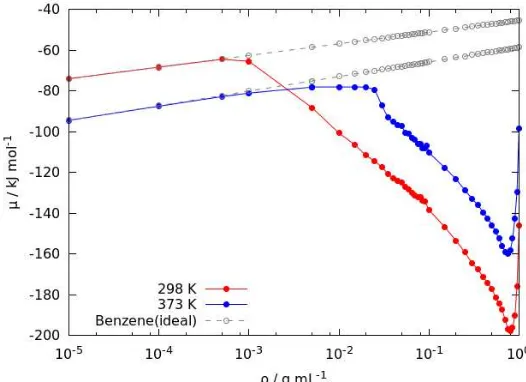The journal homepage www.jpacr.ub.ac.id ISSN : 2302 -‐ 4690
115
Chemical Potential of Benzene Fluid from Monte Carlo
Simulation with Anisotropic United Atom Model
Mahfuzh Huda,1 Siti Mariyah Ulfa,1 Lukman Hakim1*
1Department of Chemistry, Faculty of Mathematic and Science, Brawijaya University,
Jl. Veteran, Malang, Indonesia
*
Corresponding email : lukman.chemist@ub.ac.id
Received 12 August 2013; Accepted 16 September 2013
ABSTRACT
The profile of chemical potential of benzene fluid has been investigated using Anisotropic United Atom (AUA) model. A Monte Carlo simulation in canonical ensemble was done to obtain the isotherm of benzene fluid, from which the excess part of chemical potential was calculated. A surge of potential energy is observed during the simulation at high temperature which is related to the gas-liquid phase transition. The isotherm profile indicates the tendency of benzene to condensate due to the strong attractive interaction. The results show that the chemical potential of benzene rapidly deviates from its ideal gas counterpart even at low density.
Keywords: Benzene, Anisotropic United Atom, chemical potential, Monte Carlo simulation
INTRODUCTION
Benzene is an attractive subject from both scientific and industrial perspectives. It represents the interaction of aromatic π-systems which immensely control the stability of protein and nucleic acid [1]. Benzene is widely used in laboratory, petrochemical, and other industry either as additive, solvent, or raw materials. The extent of benzene usage increases the risk of benzene exposure to the environment. US Enviromental Protection Agency classified benzene as a carcinogen, and recommended activated carbon adsorption as a control to prevent benzene intrusion to the environment [2].
Grand Canonical Monte Carlo (GCMC) simulation is useful to study the adsorption of a compound at equilibrium condition, in which the chemical potential of component in the adsorbed phase is equivalent to the bulk phase [3]. Nguyen and co-workers had investigated the adsorption of benzene in graphitic slit pore in the presence of water molecules [4], and Klomkiang had reported the multilayer adsorption of benzene on a graphite surface [5]. Both used GCMC simulation with TraPP-EH model of benzene [6] which consists of 12 Lennard Jones and Coulomb interaction sites; thus the calculation of potential energy of a system with N molecules of benzene would involve 242×N(N−1) pair-interactions. The chemical potential of benzene was treated by assuming benzene fluid as an ideal gas in both works.
The journal homepage www.jpacr.ub.ac.id ISSN : 2302 -‐ 4690
116
computational resources needed to carry out the simulation. The model has been reported to accurately reproduce the physical properties of benzene [7]. Similarly, the rigid body model of water, for example, is known to reproduce many important properties of water [8] with less computational cost as compared to some flexible models of water [9]. In case of cyclic organic compound model, the inclusion of pseudorotation in a twist-model of tetrahydrofuran has been reported to give a negligible difference on thermodynamic data obtained with a simpler planar model [10].
While the AUA is a promising model to be utilized in the study of benzene system, the chemical potential of benzene fluid (gas and liquid) using this model is not known. The chemical potential information is essential to carry out a GCMC simulation for the study of adsorption, for example. Even though some works [4, 5] had reported the treatment of chemical potential of benzene using ideal gas assumption, it is intriguing to question the density limit of which benzene fluid can be fairly treated as an ideal gas. In this work, we provide a realistic chemical potential of benzene fluid of AUA model using simple calculation from the isotherm data which were priorly obtained using Monte Carlo simulation in canonical ensemble. The characteristic of potential energy and chemical potential of this model is also discussed. We show that the chemical potential of benzene fluid rapidly deviates from ideal state even at low density due to the strong intermolecular interaction.
SIMULATION METHOD Interaction model
The potential energy of system Φ is described as the sum of pair-interaction ϕij
between a pair of benzenes (noted here as i and j) in the absence of any external field
Φ =X
where r is the position and Ω is the orientation of benzene molecule. The interaction between a pair of benzene molecules is described with Anisotropic United Atom (AUA) potential model. In this model, six interaction sites are located outside of constituent atoms (Figure 1), and each site is described as Lennard-Jones (LJ) 12-6 potential. The potential energy arises from a pair of benzene molecules is then
φij(ri,rj,Ωi,Ωj) = geometry parameters (the distance shift of potential site from carbon atom δ, the distance of carbon atom from the center of mass rCC, and the angle between carbon atoms Θ) used in this
research are summarized in Table 1. These parameters have been reported to accurately reproduce several thermodynamics data such as saturated vapor pressure, vaporization enthalpy, and liquid density [7]. The pair potential energy is truncated smoothly at (rc =) 12 Å
and the discontinuity is avoided by using a switching function fs [11],
fs(r) =
(r−rc)3{10(r−rl)2−5(r−rl)(r−rc)−(r−rc)2}
The journal homepage www.jpacr.ub.ac.id ISSN : 2302 -‐ 4690
117
where r is the distance between two center of mass, rc is the distance where the pair-potential
is truncated, and rl is the distance where the switching function begins to take effect with rc −
rl = 2 Å.
Figure 1. Anisotropic United Atom model for Benzene. The interaction sites, showed as red circles, are located between carbon and hydrogen atom.
Table 1. The optimized parameters for AUA model of benzene
Parameter Value
σ 3.2464 Å
ε 7.428 × 10-2 kJ mol-1 δ 4.071 × 10-1 Å rCC
Θ
1.8071 Å
π / 3
Simulation Procedure
Monte Carlo simulations in canonical ensemble are carried out to obtain the isotherm data of benzene fluid. In this ensemble, the number of molecules N, temperature T, and volume V are kept constant during the simulation. The temperature state is chosen to be 298.15 and 373.15 K, and the investigated density is chosen from 10−5 to 1.0 g mL−1. Benzene molecules (N = 216) are implemented in a cubic simulation cell with a starting configuration of simple cubic crystal. Standard periodic boundary condition with minimum image convention is adopted in this simulation to overcome the surface effects due to the limited size of the simulation cell [12]. Each Monte Carlo step consists of a trial to translate and rotate a benzene molecule, which is chosen randomly based on uniform distribution, and the transition from old configuration m to the new configuration n has a probability P of
Pm→n=
Pn
Pm =e
−(E
n−Em)/kBT
✓sinθn i
sinθm
i
◆
(4) with E is the potential energy of system, kB is Boltzmann constant, T is temperature, and θ is
The journal homepage www.jpacr.ub.ac.id ISSN : 2302 -‐ 4690
118
RESULT AND DISCUSSION
Characteristic of the Pair Potential Energy
The potential energy arising from pair-interaction between two molecules of ben- zene with AUA model, which consists of six LJ interaction sites, are presented in Figure 2. The switching function is not applied in this case. The orientation of a benzene molecule greatly affects the potential energy arising from its interaction with the sur- rounding molecules. The variation of potential energy due to the change of orientation of benzene molecules is expressed in Figure 2a as the standard deviation bar. Neverthe- less, the average of potential energy is following the shape of LJ 12-6 potential. When the distance between molecules is close, the variation of potentials energy are expectedly large due to the possibility of an overlap between constituent atoms. As the separation distance grows large, the effect of orientation to the potential energy become less signifi- cant. The variation is less than 1 kJ mol−1 at a distance larger than 12 Å, which is the reference for choosing the pair-potential cut-off distance rc.
As a comparison, the potential energy of interaction between a pair of individual interaction sites is shown in Figure 2b. It shows that the combination of interaction sites in a benzene molecule gives an energy profile with deeper curve which vanishes slower, i.e. the interaction has a longer range, compared to the individual interaction site. These phenomena are not exclusive to atomic case since aggregate of molecules, such as in colloid system, is known to have long range interaction compared to individual molecule in solution system.
Figure 2. Pair potential energy φij of benzenes (a) averaged over all orientation with the variation is described as the standard deviation bar and (b) compared to the potential energy
between a pair of individual interaction sites (red curve).
Potential energy of the system
The journal homepage www.jpacr.ub.ac.id ISSN : 2302 -‐ 4690
119
Figure 3. The potential energy of benzene fluid system as a function of density ρ
Isotherm of benzene fluid
The pressure p of system in the Monte Carlo simulation is obtained by calculating the internal Virial term w, that is the cross product of pair distance rij and force Fij summed over
all pairs:
pV =N kBT +1 3
X
i X
j>i
rij ·Fij
(5)
Fij = rφij (6)
The relation of density and pressure of benzene fluids obtained from Monte Carlo simu- lation at constant temperature is shown in Figure 4. The negative pressure indicates the tendency of benzene to condensate under the studied condition. At higher temperature, the tendency of benzene to condensate is lower as indicated by the increase of pressure overall. It is important to note that the negative pressure is peaked near the density of 0.85 g mL−1 at T = 298.15 K, which is close to the density of benzene fluid as observed in experiment at 298.15 K and 1 atm. Further compression lead to the rapid increase of pressure.
The journal homepage www.jpacr.ub.ac.id ISSN : 2302 -‐ 4690
120
Chemical potential of benzene fluid
The chemical potential of a single-component system µg can calculated by [13]
µg(T, p) =kBT[ln{ρΛ}
3
−1 + ln{h2/4π2IkBT}]+ Z ρ
0
(p−ρkBT)/ρ 2
dρ+p/ρ
(7)
where Λ is thermal De Broglie wavelength, h is Planck constant, and I is the inertia moment. The first term in Eq. 7 is the ideal chemical potential and the latter term is the excess chemical potential which can be solved numerically using isotherm data.
The results are shown in Figure 5 together with the chemical potential of benzene as an ideal gas. The chemical potential of benzene fluids resembles its ideal gas counterpart at low density where interactions between benzene molecules are practically negligible due to long separation distance. However, as the density increases, the interaction between benzene molecules caused the chemical potential to deviates from those of ideal gas. In particular, strong interaction between benzene molecules, as shown in Figure 2, caused the deviation to occur rapidly at even low density. At T = 298.15 K, the deviation occurs when the density of benzenes fluid is higher than 1 × 10−3 g mL−1, which correspond to the system pressure of 3.27 × 10−1 atm. On the other hand, at T = 373.15 K, the deviation start to occur when the density is higher than 2.5 × 10−2 g mL−1. Considering that benzene is more stable as a gas phase at higher temperature, it is reasonable that the deviation takes place at higher density for high temperature, compared to those at low temperature. At T = 298.15 K, the chemical potential also has its lowest value around density of 0.85 g mL−1 which indicates the benzene preference to this density. At low density, the chemical potential of benzene at T = 373.15 K is lower than that of T = 298.15 K; but following the increase of density, this situation is reversed.
The journal homepage www.jpacr.ub.ac.id ISSN : 2302 -‐ 4690
121
CONCLUSION
The isotherm of benzene fluid can be obtained by performing a Monte Carlo sim- ulation in canonical ensemble with the Anisotropic United Atoms model. The excess part of chemical potential of benzene fluid of this model then can be calculated using the isotherm data to give a realistic chemical potential whose trend is conceivable at 298.15 and 373.15 K. The results shows that benzene fluid deviates from ideal gas behavior even at a density as low as 1 × 10−3 g mL−1 (gas phase), which correspond to the pressure of 3.27 × 10−1 atm; thus highlight the importance of the excess part of chemical potential in the study of benzene.
ACKNOWLEDGMENT
The simulations were carried out using Intel Xeon hexacore workstation which was arranged from PHBI research grant through DIPA Universitas Brawijaya No. 0636/023- 04.2.16/15/2012 from The Directorate General of Higher Education, Indonesian Ministry of Education.
REFERENCES
[1] Burley, S.K., Pekko, G. A., Science, 1985, 229, 23.
[2] Derbyshire, F., Jagtoyen, M., Andrews, R., Rao, A., Martin-Gullon, I., Grulke E.A., Carbon Materials in Environmental Applications, 2000, 27, 166.
[3] Hakim, L., Koga, K., and Tanaka, H., Phys. Rev. Lett., 2010, 104, 115701.
[4] Nguyen, P. T. M., Do, D. D., and Nicholson, D., J. Phys. Chem. C, 2012, 116, 13954. [5] Klomkliang, N., Do, D. D., Nicholson, D., Tangsathitkulchai, C., Wongkoblap, Chem.
Eng. Sci., 2012, 69, 472.
[6] Rai, N., Siepmann, J. I., J. Phys. Chem. B, 2007, 111, 10790.
[7] Contreras-Camacho, R. O., Ungerer, P., Boutin, A., and Mackie, A. D., J. Phys. Chem. B, 2004, 108, 14109.
[8] Koyama, Y., Tanaka, H., Gao, G., and Zeng, X. C., J. Chem. Phys., 2004, 121, 7926. [9] Guillot, B., J. Mol. Liq., 2002, 101, 219.
[10] Chandrasekhar, J., and Jorgensen, W. L., J. Chem. Phys., 1982, 77, 5073. [11] Hakim, L., Kenichiro, K., and Tanaka, H., Phys. Rev. B, 2010, 82, 144105.
[12] Allen. M. P., and Tildesley D. J., Computer Simulation of Liquids, 1991, Oxford University Press, New York.



